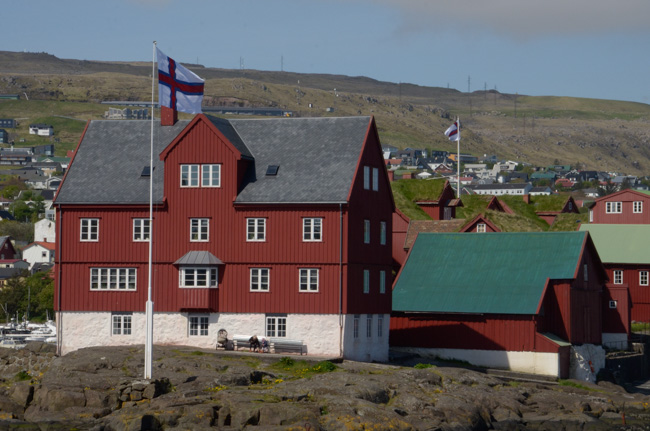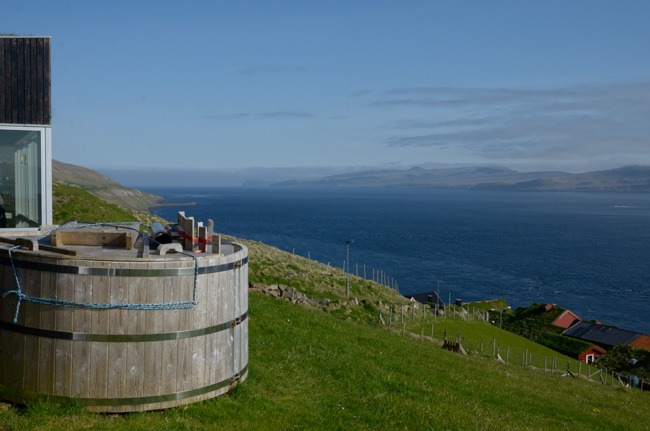The ferry brought us back to Tórshavn where we enjoyed a walking tour of the old town and then had time to shop or otherwise wander on our own.

The downtown "square" is a marina.

Nólsoyar Páll is an 18th century Faroese national hero honored by a sculpture on the harbor square. He struggled unsuccessfully to break the Danish control of trade with the Faroe Islands. A poet, among other accomplishments, he wrote a satirical poem called "Battle of the Birds" in which birds of prey symbolize the Danish authorities. He cast himself in the role of the oystercatcher, who warns and protects the smaller birds.
The sculpture overlooking the harbor depicts the seafaring poet and an oystercatcher harassing a raven symbolizing the colonial Danish trade monopoly. It is by Hans Pauli Olsen.
Although the Faroe Islands are still a Danish possession, they are independently governed. The spirit of independence is strong enough that when Denmark elected to join the EU, the Faroes elected not to do so.

After returning to Torshavn, we had a walking tour of Tinganes, the old heart of the city. It sits on a rocky headland dividing the harbor. The red-painted buildings were once warehouses and are now government buildings.
The Faroe Islands have a credible claim to the oldest legislative & judicial assembly. The ting is documented as early as 999 but by then it was a going concern. It has not, however, been in continuous existence as it was abolished in 1816 and not reconstituted until 1852.
The islands have been a self-governing jurisdiction within Denmark since 1948.

The black-painted buildings in Tinganes are residences. Occupants receive government subsides to help with maintenance. Some of the structures date to the late 17th century. A fire in 1673 destroyed all previous ones.

Carvings on the rocks of the headland are believed to indicate where various Ting representatives had their position. One carving, however, is an accurate compass rose.

Rowing traditional boats is a major sport in the Faroe Islands. We had enjoyed watching this team row around the harbor during our visit. The boat belongs to the Róðrarfelagið Knørrur rowing club based in Torshavn.
That morning on our visit to Nólsoy we watched two young boys, perhaps 6-8, rowing around the harbor in a petite rowboat. They're getting started early.

The weather is notoriously foggy, rainy, chilly and changeable. Everywhere we went the locals were basking in the (comparitively) warm sunshine.
 Did I mention the fabulous food? That evening Óli & Anna
welcomed us for a many-course traditional dinner.
Did I mention the fabulous food? That evening Óli & Anna
welcomed us for a many-course traditional dinner.
Our hosts paired the courses with a variety of beers made from their own brewery. Our guides Jim Wilson (L) and Tom Sharpe are shown with the host Óli (R). We have traveled with Jim & Tom before are were happy to hear that they would be included in the staff for this expedition. We were even more thrilled to learn that they would lead this extension.

As we reached the "farm" where we would have dinner, many were puzzled that it looked more like a standard housing development back home than anyone's idea of a farm. The holding right around the house may have been only a few acres of steep pasture, but it had been in the family for several generations. There is only one family on the islands that are full-time farmers. All the rest have "day jobs."
The house was relatively new and had been purpose-built for the family's new occupation of Heimablídni.
The sheep were pastured elsewhere on the island's open range. Óli told us that individual farmers mark their sheep with ear tags and that the sheep don't tend to wander far from their home range, so they don't get "lost." More on sheep later.
Click your "back" button to return to the previous page or click for our picture album.